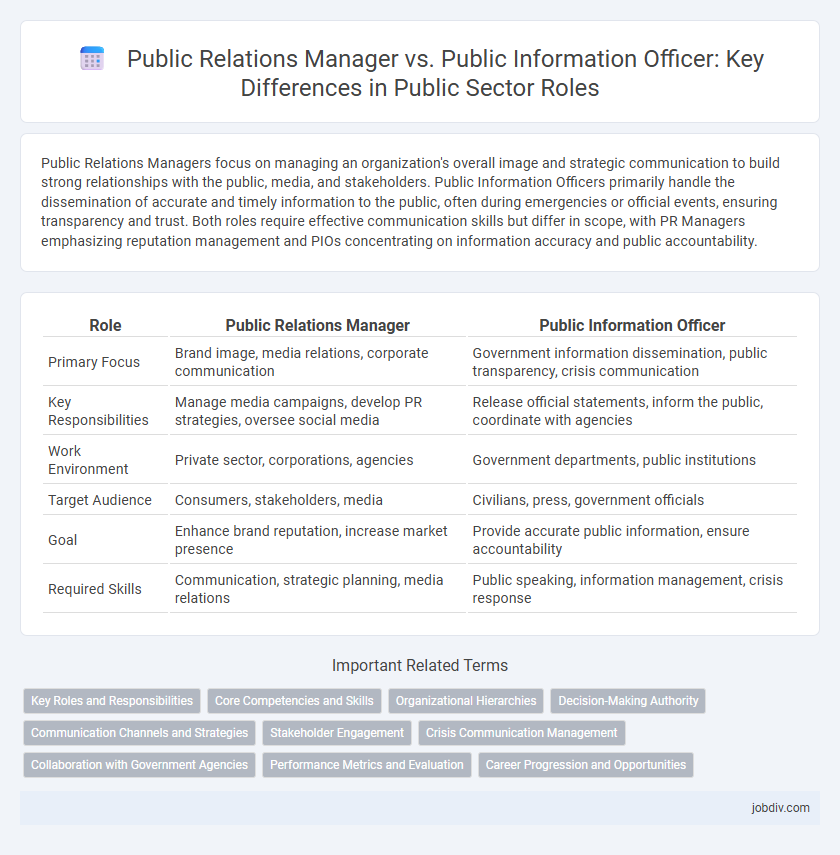Public Relations Managers focus on managing an organization's overall image and strategic communication to build strong relationships with the public, media, and stakeholders. Public Information Officers primarily handle the dissemination of accurate and timely information to the public, often during emergencies or official events, ensuring transparency and trust. Both roles require effective communication skills but differ in scope, with PR Managers emphasizing reputation management and PIOs concentrating on information accuracy and public accountability.
Table of Comparison
| Role | Public Relations Manager | Public Information Officer |
|---|---|---|
| Primary Focus | Brand image, media relations, corporate communication | Government information dissemination, public transparency, crisis communication |
| Key Responsibilities | Manage media campaigns, develop PR strategies, oversee social media | Release official statements, inform the public, coordinate with agencies |
| Work Environment | Private sector, corporations, agencies | Government departments, public institutions |
| Target Audience | Consumers, stakeholders, media | Civilians, press, government officials |
| Goal | Enhance brand reputation, increase market presence | Provide accurate public information, ensure accountability |
| Required Skills | Communication, strategic planning, media relations | Public speaking, information management, crisis response |
Key Roles and Responsibilities
Public Relations Managers develop and implement strategic communication plans to enhance an organization's image, manage media relations, and coordinate promotional campaigns. Public Information Officers primarily focus on disseminating accurate and timely information to the public and media during emergencies or routine operations, acting as the organization's official spokesperson. Both roles require strong communication skills, but PR Managers emphasize brand reputation and marketing, while PIOs prioritize transparency and information dissemination.
Core Competencies and Skills
Public Relations Managers excel in strategic communication, brand management, and media relations, leveraging creativity and leadership skills to build and maintain a positive public image. Public Information Officers specialize in crisis communication, government relations, and information dissemination, requiring strong skills in accuracy, timeliness, and regulatory compliance. Both roles demand expertise in communication strategies, stakeholder engagement, and content development tailored to their specific organizational goals.
Organizational Hierarchies
Public Relations Managers typically oversee strategic communication initiatives within an organization's marketing or corporate communications department, managing external and internal messaging to enhance brand reputation. Public Information Officers usually serve within government agencies or public institutions, acting as official spokespersons and coordinating information dissemination to the public and media according to organizational protocols. Organizational hierarchies often position Public Relations Managers higher in decision-making roles related to brand strategy, while Public Information Officers focus more on compliance, transparency, and direct public engagement within their specific agencies.
Decision-Making Authority
A Public Relations Manager typically holds greater decision-making authority, overseeing comprehensive communication strategies and managing brand reputation with the capacity to make high-level executive decisions. In contrast, a Public Information Officer usually operates within government or public sector agencies, primarily responsible for disseminating accurate information and responding to public inquiries while following established protocols and directives. The extent of decision-making authority in Public Information Officers is generally more limited, focusing on message delivery rather than strategic communication planning.
Communication Channels and Strategies
Public Relations Managers leverage diverse communication channels, including social media platforms, press releases, and events, to shape organizational image and engage target audiences proactively. Public Information Officers primarily utilize official communication channels like government websites, press briefings, and public service announcements to disseminate accurate and timely information during crises or public interest situations. PR Managers focus on strategic audience segmentation and brand storytelling, whereas PIOs emphasize transparency, factual reporting, and crisis communication protocols.
Stakeholder Engagement
Public Relations Managers concentrate on cultivating relationships with a broad range of stakeholders, including media, customers, and community groups, to enhance an organization's reputation and brand perception. Public Information Officers primarily focus on disseminating accurate and timely information to the public and government entities, emphasizing transparency and crisis communication. Both roles require strategic communication skills, but PR Managers engage stakeholders through proactive brand storytelling, whereas Public Information Officers prioritize official information dissemination and regulatory compliance.
Crisis Communication Management
Public Relations Managers excel in strategic crisis communication management by crafting targeted messaging to protect brand reputation and engage diverse stakeholders through multiple channels. Public Information Officers specialize in transparent information dissemination during crises, coordinating with government agencies to ensure accurate, timely updates that maintain public trust. Both roles require expertise in media relations, but PR Managers emphasize reputation control while Public Information Officers prioritize public safety and compliance.
Collaboration with Government Agencies
Public Relations Managers often coordinate with government agencies to shape public perception and manage media relations through strategic campaigns and communication plans. Public Information Officers serve as official spokespersons, providing accurate and timely information to the public and ensuring compliance with government regulations and transparency requirements. Collaboration between these roles enhances consistent messaging, crisis communication, and effective dissemination of public policies.
Performance Metrics and Evaluation
Performance metrics for Public Relations Managers typically emphasize brand reputation, media coverage quality, and campaign ROI, while Public Information Officers are evaluated based on accuracy, timeliness, and clarity of information dissemination. PR Managers often utilize tools like media monitoring services and sentiment analysis to measure public perception, whereas PIOs rely on stakeholder feedback, crisis communication effectiveness, and compliance with public disclosure requirements. These distinct evaluation criteria reflect their roles: PR Managers focus on strategic image-building, and PIOs prioritize transparent and factual public communication.
Career Progression and Opportunities
Public Relations Managers typically advance by leading strategic communication campaigns and managing media relations to enhance brand reputation, while Public Information Officers progress through roles emphasizing information dissemination and crisis communication within government or public sectors. Career opportunities for Public Relations Managers often expand into corporate communications, marketing leadership, or consultancy positions, whereas Public Information Officers may move into senior advisory roles, public affairs, or policy development. Both career paths demand strong writing, interpersonal, and media skills but diverge in focus between promotional strategies and public service information transparency.
Public Relations Manager vs Public Information Officer Infographic

 jobdiv.com
jobdiv.com